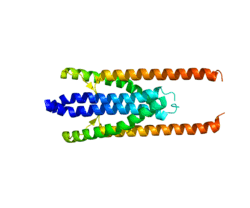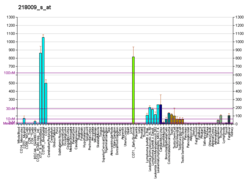PRC1
Protein Regulator of cytokinesis 1 (PRC1) is a protein that in humans is encoded by the PRC1 gene and is involved in cytokinesis.[5][6]
Function
PRC1 protein is expressed at relatively high levels during S and G2/M phases of the cell cycle before dropping dramatically after mitotic exit and entrance into G1 phase. PRC1 is located in the nucleus during interphase, becomes associated with the mitotic spindle in a highly dynamic manner during anaphase, and localizes to the cell midbody during cytokinesis. PRC1 was first identified in 1998 using and ''in vitro'' phosphorylation screening method and shown to be a substrate of several cyclin-dependent kinases (CDKs).[5] Correspondingly, ablation of PRC1 has been shown to disrupt spindle midzone assembly in mammalian systems.[7]
At least three alternatively spliced transcript variants encoding distinct isoforms of PRC1 have been observed.[6] Additionally, PRC1 has sequence homology with Ase1 in yeasts, SPD-1 (spindle defective 1) in C. elegans, Feo in D. melanogaster, and MAP65 in plants, all of which fall in a conserved family of nonmotor microtubule-associated proteins (MAPs).[8][9][10]
Structure
The crystal structure of PRC1 has only recently been characterized in vitro. In 2013, PRC1 was illustrated as a lengthy molecule consisting of a C-terminal spectrin microtubule-binding domain, an extended rod domain, and an N-terminal dimerization domain.[9][11] Consisting of an intricate arrangement of α-helices, the rod domain, together with the dimerization-conducting N terminus cooperate to facilitate binding of other proteins, such as Kinesin-4, to PRC1. PRC1’s rod domain adopts multiple conformations, all affected by its C-terminal spectrin domain. A model has been suggested in which PRC1 is likely to be a flexible molecule both in solution and on single microtubules but becomes more rigid when the microtubule-binding domains are restricted with antiparallel microtubule filament crosslinking, seen at the spindle midzone. The overall structure of the PRC1 homodimer is reminiscent of actin-bundling proteins, and this process of microtubule filament crosslinking is similar to that of actin.[9]
Role in cytokinesis
PRC1’s role in midzone microtubule formation, essential to the cytokinetic machinery of mammals, is made possible through its collaboration with Kinesin-4 in setting up a controlled zone of overlapping, antiparallel microtubules at the spindle midzone.[12] PRC1 is normally inhibited until anaphase onset by CDK1 mediated phosphorylation, preventing its dimerization. Upon anaphase onset and removal of inhibitory CDK1 phosphorylation, PRC1 dimers form. These homodimers specifically recognize antiparallel microtubule overlaps, found at the spindle midzone, and bind, allowing microtubule sliding, cross-linking of microtubule filaments, and assembly of central-spindle-mediating proteins, including but not limited to Kinesin-4.[12][13]
PRC1 dimers, required for the high-affinity interaction with Kinesin-4, recruit Kinesin-4 to regions of antiparallel microtubule overlap, where Kinesin-4, a plus-end directed motor protein that inhibits microtubule dynamics, helps to form length-dependent end tags that help stabilize and regulate spindle microtubule assembly within cytokinesis.[9][12] This PRC1-Kinesin-4 complex differentially identifies and regulates the spindle midzone microtubules during cell division.[12] This regulation is crucial in order for cytokinesis to progress properly.
Interactions
- PRC1 is a non-motor microtubule-associated protein (MAP) whose C-terminal spectrin domain (aa 341-640) binds microtubules with micromolar affinity (0.6 +/- 0.3uM) [14]
- PRC1 has been shown to interact with TRIM37.[15]
- PRC1 interacts with Kinesin-4 that plays an important role in crossing spindle microtubules and setting midzone length in mammalian cytokinesis.[9]
- PRC1 is negatively modulated by CDKs, particularly CDK1.[13]
- PLK1 negatively regulates PRC1 through phosphorylation at Thr-602, near the C-terminus of PRC1, only after dephosphorylation of PRC1 at an inhibitory CDK1 site.[12][16]
- PRC1 binds directly to CYK-4 subunit of the centralspindlin complex to stabilise the central spindle.[17]
References
- 1 2 3 GRCh38: Ensembl release 89: ENSG00000198901 - Ensembl, May 2017
- 1 2 3 GRCm38: Ensembl release 89: ENSMUSG00000038943 - Ensembl, May 2017
- ↑ "Human PubMed Reference:".
- ↑ "Mouse PubMed Reference:".
- 1 2 Jiang W, Jimenez G, Wells NJ, Hope TJ, Wahl GM, Hunter T, Fukunaga R (1998). "PRC1: a human mitotic spindle-associated CDK substrate protein required for cytokinesis". Mol. Cell. 2 (6): 877–85. doi:10.1016/S1097-2765(00)80302-0. PMID 9885575.
- 1 2 "Entrez Gene: PRC1 protein regulator of cytokinesis 1".
- ↑ Eggert US, Mitchison TJ, Field CM (2006). "Animal Cytokinesis: From Parts List to Mechanisms". Annu. Rev. Biochem. 75: 543–66. doi:10.1146/annurev.biochem.74.082803.133425. PMID 16756502.
- ↑ Bieling P, Telley IA, Surrey T (2010). "A Minimal Midzone Protein Module Controls Formation and Length of Antiparallel Microtubule Overlaps". Cell. 142 (3): 420–32. doi:10.1016/j.cell.2010.06.033. PMID 20691901.
- 1 2 3 4 5 Subramanian R, Ti SC, Tan L, Darst SA, Kapoor TM (2013). "Marking and Measuring Single Microtubules by PRC1 and Kinesin-4". Cell. 154: 377–90. doi:10.1016/j.cell.2013.06.021. PMC 3761943. PMID 23870126.
- ↑ Vernì F, Somma MP, Gunsalus KC, Bonaccorsi S, Belloni G, Goldberg ML, Gatti M (2004). "Feo, the Drosophila Homolog of PRC1, Is Required for Central-Spindle Formation and Cytokinesis". Curr. Biol. 14 (17): 1569–75. doi:10.1016/j.cub.2004.08.054. PMID 15341744.
- ↑ Hu CK, Coughlin M, Mitchison TJ (2012). "Midbody assembly and its regulation during cytokinesis". Mol. Biol. Cell. 23: 1024–34. doi:10.1091/mbc.E11-08-0721. PMC 3302730. PMID 22278743.
- 1 2 3 4 5 Bechstedt S, Brouhard GJ (2013). "Motors and MAPs Collaborate to Size Up Microtubules". Dev. Cell. 26 (2): 118–20. doi:10.1016/j.devcel.2013.07.010. PMID 23906062.
- 1 2 Fededa JP, Gerlich DW (2012). "Molecular Control of animal cell cytokinesis". Nat. Cell Biol. 14 (5): 440–7. doi:10.1038/ncb2482. PMID 22552143.
- ↑ Subramanian R, Wilson-Kubalek EM, Arthur CP, Bick MJ, Campbell EA, Darst SA, Milligan RA, Kapoor TM (Aug 2010). "Insights into antiparallel microtubule crosslinking by PRC1, a conserved nonmotor microtubule binding protein". Cell. 142 (3): 433–43. doi:10.1016/j.cell.2010.07.012. PMC 2966277. PMID 20691902.
- ↑ Rual JF, Venkatesan K, Hao T, Hirozane-Kishikawa T, Dricot A, Li N, Berriz GF, Gibbons FD, Dreze M, Ayivi-Guedehoussou N, Klitgord N, Simon C, Boxem M, Milstein S, Rosenberg J, Goldberg DS, Zhang LV, Wong SL, Franklin G, Li S, Albala JS, Lim J, Fraughton C, Llamosas E, Cevik S, Bex C, Lamesch P, Sikorski RS, Vandenhaute J, Zoghbi HY, Smolyar A, Bosak S, Sequerra R, Doucette-Stamm L, Cusick ME, Hill DE, Roth FP, Vidal M (2005). "Towards a proteome-scale map of the human protein-protein interaction network". Nature. 437 (7062): 1173–8. doi:10.1038/nature04209. PMID 16189514.
- ↑ Hu CK, Ozlü N, Coughlin M, Steen JJ, Mitchison TJ (2012). "Plk1 negatively regulates PRC1 to prevent premature midzone formation before cytokinesis". Mol. Biol. Cell. 23 (4): 2702–11. doi:10.1091/mbc.E12-01-0058. PMC 3395659. PMID 22621898.
- ↑ Lee KY, Esmaeili B, Zealley B, Mishima M (2015). "Direct interaction between centralspindlin and PRC1 reinforces mechanical resilience of the central spindle". Nature Communications. 6: 7290. doi:10.1038/ncomms8290. PMC 4557309. PMID 26088160.
Further reading
- Mollinari C, Kleman JP, Jiang W, Schoehn G, Hunter T, Margolis RL (2002). "PRC1 is a microtubule binding and bundling protein essential to maintain the mitotic spindle midzone". J. Cell Biol. 157 (7): 1175–86. doi:10.1083/jcb.200111052. PMC 2173564. PMID 12082078.
- Ban R, Irino Y, Fukami K, Tanaka H (2004). "Human mitotic spindle-associated protein PRC1 inhibits MgcRacGAP activity toward Cdc42 during the metaphase". J. Biol. Chem. 279 (16): 16394–402. doi:10.1074/jbc.M313257200. PMID 14744859.
- Kurasawa Y, Earnshaw WC, Mochizuki Y, Dohmae N, Todokoro K (2005). "Essential roles of KIF4 and its binding partner PRC1 in organized central spindle midzone formation". EMBO J. 23 (16): 3237–48. doi:10.1038/sj.emboj.7600347. PMC 514520. PMID 15297875.
- Li C, Lin M, Liu J (2005). "Identification of PRC1 as the p53 target gene uncovers a novel function of p53 in the regulation of cytokinesis". Oncogene. 23 (58): 9336–47. doi:10.1038/sj.onc.1208114. PMID 15531928.
- Mollinari C, Kleman JP, Saoudi Y, Jablonski SA, Perard J, Yen TJ, Margolis RL (2005). "Ablation of PRC1 by small interfering RNA demonstrates that cytokinetic abscission requires a central spindle bundle in mammalian cells, whereas completion of furrowing does not". Mol. Biol. Cell. 16 (3): 1043–55. doi:10.1091/mbc.E04-04-0346. PMC 551472. PMID 15616196.
- Zhu C, Jiang W (2005). "Cell cycle-dependent translocation of PRC1 on the spindle by Kif4 is essential for midzone formation and cytokinesis". Proc. Natl. Acad. Sci. U.S.A. 102 (2): 343–8. doi:10.1073/pnas.0408438102. PMC 544298. PMID 15625105.
- Rual JF, Venkatesan K, Hao T, Hirozane-Kishikawa T, Dricot A, Li N, Berriz GF, Gibbons FD, Dreze M, Ayivi-Guedehoussou N, Klitgord N, Simon C, Boxem M, Milstein S, Rosenberg J, Goldberg DS, Zhang LV, Wong SL, Franklin G, Li S, Albala JS, Lim J, Fraughton C, Llamosas E, Cevik S, Bex C, Lamesch P, Sikorski RS, Vandenhaute J, Zoghbi HY, Smolyar A, Bosak S, Sequerra R, Doucette-Stamm L, Cusick ME, Hill DE, Roth FP, Vidal M (2005). "Towards a proteome-scale map of the human protein-protein interaction network". Nature. 437 (7062): 1173–8. doi:10.1038/nature04209. PMID 16189514.
- Nousiainen M, Silljé HH, Sauer G, Nigg EA, Körner R (2006). "Phosphoproteome analysis of the human mitotic spindle". Proc. Natl. Acad. Sci. U.S.A. 103 (14): 5391–6. doi:10.1073/pnas.0507066103. PMC 1459365. PMID 16565220.
- Zhu C, Lau E, Schwarzenbacher R, Bossy-Wetzel E, Jiang W (2006). "Spatiotemporal control of spindle midzone formation by PRC1 in human cells". Proc. Natl. Acad. Sci. U.S.A. 103 (16): 6196–201. doi:10.1073/pnas.0506926103. PMC 1458854. PMID 16603632.
- Beausoleil SA, Villén J, Gerber SA, Rush J, Gygi SP (2006). "A probability-based approach for high-throughput protein phosphorylation analysis and site localization". Nat. Biotechnol. 24 (10): 1285–92. doi:10.1038/nbt1240. PMID 16964243.
- Shimo A, Nishidate T, Ohta T, Fukuda M, Nakamura Y, Katagiri T (2007). "Elevated expression of protein regulator of cytokinesis 1, involved in the growth of breast cancer cells". Cancer Sci. 98 (2): 174–81. doi:10.1111/j.1349-7006.2006.00381.x. PMID 17233835.
- Subramanian R, Wilson-Kubalek EM, Arthur CP, Bick MJ, Campbell EA, Darst SA, Milligan RA, Kapoor TM (2010). "Insights into antiparallel microtubule crosslinking by PRC1, a conserved nonmotor microtubule binding protein". Cell. 142 (3): 433–43. doi:10.1016/j.cell.2010.07.012. PMC 2966277. PMID 20691902.





